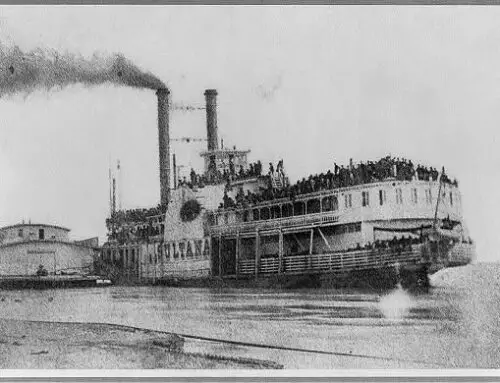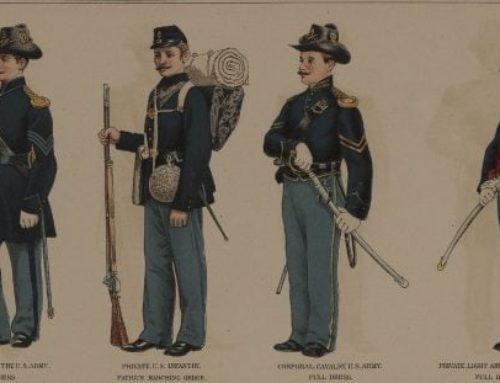The American Civil War is not generally thought of as a naval war, but Civil War ships of both sides played a significant role in the conflict. The role of the Federal and Confederate Civil War naval ships in the war is all the more remarkable when you consider the scarcity of battle worthy vessels owned by either side at the start of the war.
The Confederacy had no navy at all in 1860 and the Union Navy was in dismal shape. In 1861 Gideon Welles was appointed as Secretary of the Navy and was ordered by Lincoln to quell the rebellion with an enormous naval blockade of the Southern coast and both the blockade and gaining control of the Mississippi would be keys to the Union‘s victory.
The Union’s first truly significant victory, Grant’s capture of Fort Donelson and Fort Henry in 1862 was enabled by Civil War ships and Civil War marines.
Lincoln’s order of a naval blockade struck some of his staff as impractical. Most of the Navy’s vessels were on duty in foreign waters and only three or four ships were available for active duty.
The North also had available the USS Constitution but this ship was wind powered in an age of steam power so it was regulated to training duty.
Yet an effective blockade of the southern coast would have to cover three thousand miles. Legally, other nations were not bound to honor the blockade unless it was effective. The Union Navy Department hastened to buy commercial vessels and adapt them for warfare and commission the building of other vessels. Because the war had seriously hampered northern shipping business, owners of several large steamers pressured the government to buy them, but these ships were too large and unwieldy to patrol the shallow coast.
Also available to the Union Navy were several Civil War ships laid up in dry dock for repair, but most of these would take from two weeks to a month to repair. Fortunately, the North had both the resources and manpower to quickly build ships. With two exceptions, all of the United States Navy shipyards were in the northern states.
Although many of the navy’s Civil War ships were either on duty in foreign waters or awaiting repairs, the U.S. Navy had been improving its fleet with steam powered vessels for nearly two decades. The steam frigates Colorado, Merrimac, Minnesota, Niagara, Roanoke, and Wabash and the steam sloops-of-war Brooklyn, Dacotah, Hartford, Iroquois, Lancaster, Michigan, Narragansett, Pawnee, Pensacola, Seminole and Wyoming were relatively new ships, having been built since 1855.
Of these ships, the Brooklyn was the only one available for active duty when Lincoln first ordered the blockade. The Niagara was far away, on special duty off the coast of Japan and the Dacotah was also in Asian waters. Despite signs of an impending conflict in the months before South Carolina seceded, the Naval department had not sufficiently prepared the fleet. Naval officers who were southerners had been resigning in large numbers since South Carolina’s secession in December 1860 and classes at the Naval Academy in Annapolis, Maryland were hampered by this shortage. A newly graduated class was called to active duty to make up for the vacancies.
However, there were still 1457 officers and 7600 seamen in the federal navy; by war’s end this number would increase to 7500 officers and 51,500 seamen. These men would man an extraordinary fleet of ships built up by the Union, including the new ironclads, which would change the face of maritime warfare. By repairing available ships, building new ones, and adapting commercial vessels the Union Navy had 212 seaworthy vessels in January 1862.
The Confederate Navy had a far more difficult time in creating Civil War naval ships, for at the beginning of the war it owned no Civil War ships at all.
Norfolk and Pensacola were its only navy shipyards, although several small private firms made vessels suitable for navigating shallow river waters. Although it had no shortage of wood with which to make wooden ships, the South lacked both iron and the facilities to construct efficient steam engines.
Despite these obstacles, the Confederates managed to build up a small fleet of Civil War ships. Like the North’s flotilla, some of their vessels were converted commercial ships, hastily outfitted with guns. A few ships were captured from the North and used in the Confederate Navy. Small shipyards constructed vessels able to patrol the river waters. In May 1861, a representative from the Confederacy sailed to England in an attempt to commission the building of warships. Building warships would violate Britain’s stance as a neutral country, so the South’s representative had the ships built in his own name as merchant vessels and outfitted for war only after they sailed out of British waters. Getting a blockade runner back through the Union blockade was also difficult and grew more difficult as the Union Navy increased in size.
The Confederate fleet would never grow as large as the Union Navy, but it was slightly ahead of the North in building the first ironclad. Federal troops had evacuated the Norfolk shipyard when it became apparent that Virginia would secede. Before they left, they set fire to the seven Civil War ships left at the yard, attempting to make them unusable to the enemy. Fire destroyed six ships, but the U.S.S. Merrimac was rescued by the Confederates before it was entirely destroyed. The Confederate Naval department hastened to have it re-outfitted as a Civil War ironclad ship, an armor plated ship and re-christened it the CSS Virginia.
The Union Navy department learned of the Merrimac’s impending resurrection though spies and hastened the building of the USS Monitor, a Union ironclad commissioned at the war’s onset. The Monitor was an entirely new ship, built after a design by John Ericsson. It was technically superior to the Merrimac, being twice as fast and featuring a revolving gun turret. The Merrimac was well armored, but slow and difficult to maneuver. The Federals planned to use the Monitor to attack Merrimac while it was still in dry dock, but the quick construction of the Confederate project changed their plans.
On March 8, 1862, the newly re-christened Virginia attacked five Union ships in the harbor at Hampton Roads. It ran one aground and destroyed two others.
The next day, the Monitor arrived and the two Civil War ships shelled each other, as the Monitor circled the Virginia. The battle was a draw, but the incident marked the switch to modern naval warfare; ironclads made wooden ship obsolete.
The picture to the left shows battle damage to the USS Galena which was a type of ironclad that proved to be ineffective in combat.
The Union and Confederate Navies had many other important clashes including the first successful submarine attack made by the CSS Hunley.
The Confederate ships however were most successful in attacking Union merchant Civil War ships outside of U.S. waters, in places such as the West Indies. The general procedure was to rescue the merchant crew, but to destroy their ship. In one incident, CSS Alabama, a successful destroyer of merchant ships, clashed with the USS Kearsarge off the coast of France; this time the Union ship won.
Naval forces were essential to the Union’s victory. In April 1862, Union General Benjamin Butler was able to occupy New Orleans only because of the actions of Admiral David Farragut, his fleet and Civil War marines. The occupation of New Orleans for the rest of the war, allowed the Union to control most of the Mississippi. The fall of Vicksburg in July 1863 completed the Union control of the mighty river. The Union victory at Vicksburg was accomplished with the help of Admiral David Porter and his gunboats.
The Naval Mine also played a role during the Civil War, sinking a few ships.
A new type of gunboat, called a “double-ender” allowed the Union to manipulate shallow river waters much easier than more unwieldy Confederate ships. The “double-ender” could go backward as well as forward in the rivers, without having to turn about. The “double-enders” were made of wood, so they could be quickly constructed; however, this advantage was also a disadvantage, since wooden ships could be easily destroyed.
The need for easily manipulated Civil War ships and for ships that could not be easily destroyed prompted much technological growth during the war. The conflict was the last one in which wooden ships would be used. Although the Civil War ironclad ships were unwieldy and flawed, they ushered in the age of the modern steel warship. After the success of the Monitor and the Virginia, navies around the world began to build armored warships. The war also saw the first use of submarines and torpedoes. For a conflict not known for its naval battles, the American Civil War had made an unforgettable impact on future navies. The war was also remembered for one of the greatest maritime disasters in American history, the sinking of the Sultana in 1865.
The sinking of the Sultana was the largest naval disaster during the entire war.
































